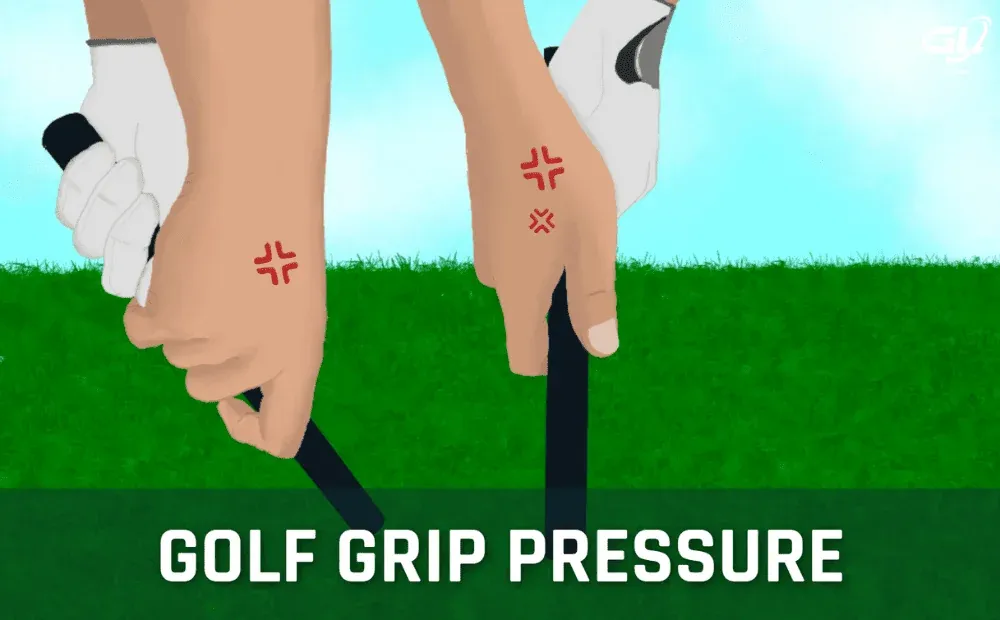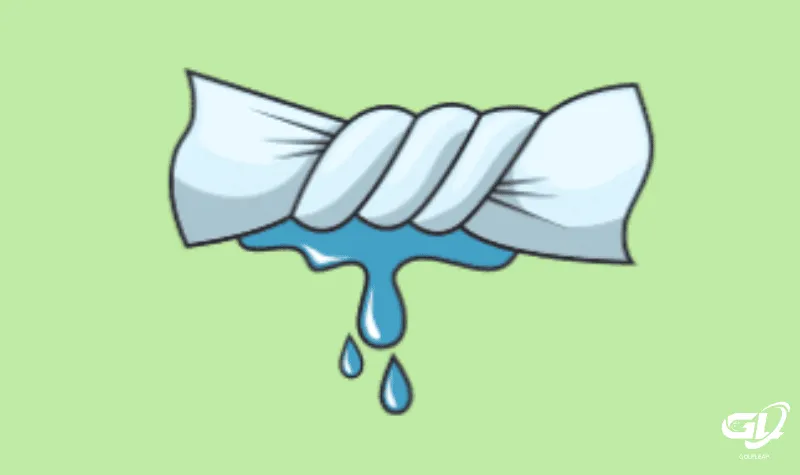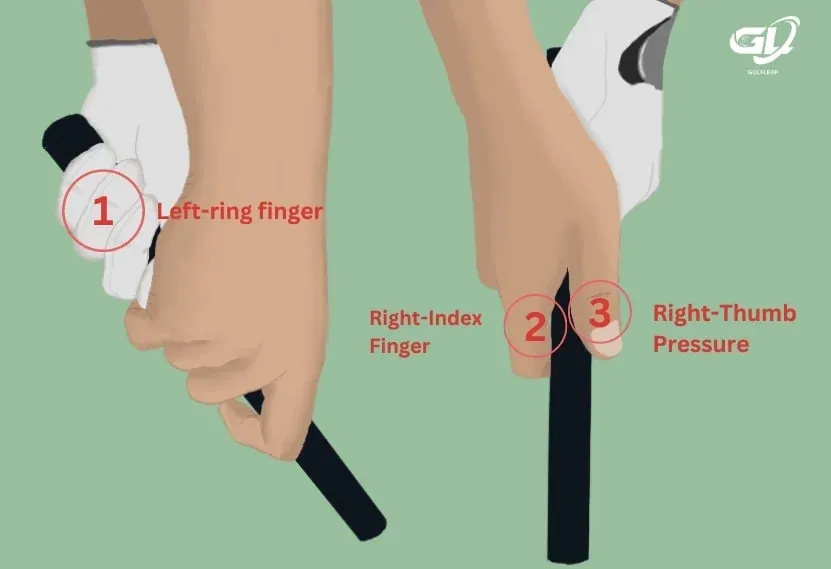
How you grip the golf club is up to you, but the amount of pressure and where to apply it on the golf grip aren’t as flexible. Your golf grip pressure plays a significant role in determining the quality of your entire golf swing. In fact, I’d say it’s probably the number one area beginner golfers overlook.
If you’re experiencing soreness in your arms, hitting the ball anywhere but straight, or your club face is twisting from your hands on impact, you’re likely applying the wrong grip pressure to your golf club.
This guide will provide the best tips, concepts, and drills for the proper golf grip pressure, as well as why it’s so important. I promise you, this will change the quality of your golf shots because it certainly did for me.
Let’s stop those clubs from flying out of our hands!
Table of Contents
How Grip Pressure Affects Your Golf Swing
How tightly you grip your golf clubs plays an immense role in determining how consistent, comfortable, powerful, and accurate your golf shot will be. That said, gripping the club too tight or too loose can lead to injury, inconsistent ball contact, and a poor golf swing regardless of how you hold the golf club.
Not to mention, where you apply the pressure on the grip is just as important. For instance, I found that removing more pressure from my left pinky that sits on the top of my grip (I’m right-handed), creates a straight-to-hook ball trajectory (something that significantly cured my slice).
What happens If you Grip Too Tightly?
Generally, the tighter your grip, the more you introduce the right hand into the swing. For some, this can lead to either a hook or a slice (depending on the golfer), but in most cases, golfers tend to slice the ball more when there’s too much grip pressure applied. One, because they struggle to close the club face on impact due to their overly tight grip. And two, because they end up swinging over the top due to an over-dominating right hand, resulting in a frustrating push-slice.
Another consequence is a rigid golf swing. When your grip is tight, tension builds on your wrist and forearms, which transfers to your entire body, especially your shoulders. What ends up happening is you’ll fail to generate good clubhead speed, you’re swing tempo goes off as you’ll feel ‘stuck’ while transitioning from the top of your backswing, and you fail to release the club after impact. Not to mention, injuries! When your grip and body are all tense, mis-hits on the golf ball hurt and you’re more likely to overwork a muscle. The worst is if you injure your back or end up with a golfer’s elbow!
What happens If You Grip Too Loosely?
Holding the club too loose will also bring its own set of problems. The first one is safety (we don’t want the club flying into someone else’s face).
Another issue with gripping the club too loose is you end up having almost no control of your clubface. Some form of strength should be applied to encourage good wrist control in the golf swing. That’s about it really!
How to Tell If You’re Gripping the Club Too Tight or Too Loose?
A quick way to determine a grip that’s too tight is soreness in the forearms, palms, and/ or fingers. If it’s not your first day hitting a golf club, then you shouldn’t feel any soreness in those areas. Another way to tell is to have your golf buddy feel your forearms at address, if they’re flexed and hard as a rock, you’re likely gripping too tight. What you want is firmness that doesn’t come with flexing the forearms.
To diagnose a grip that’s too loose is if the club is twisting easily on impact (or if they’re flying out of your hands), most mishits should not result in the club twisting within your grips. If that’s the case, try gripping slightly harder, but if that ends up feeling uncomfortable, it is likely the issue with the grip being too small or not fitting your hands. For that, go check with a Pro shop and ask them to fit the proper sized grip for your hands!
How Tightly Should You Hold The Golf Clubs?

So how much pressure should we apply to the grip? Personally, I don’t find using a scale from 1-10 to express grip pressure is accurate, since my feel of a 5 out of 10 grip pressure may be your 8!
What I like to do instead, and this works almost every time, is to use the ‘wet-towel‘ analogy when addressing grip pressure. Imagine squeezing a soaked wet rag with both your hands just to the point where the water is about to drip. That’s the pressure to apply to the grip! (P. S. You don’t have to grab a wet towel to do this. I found that imagining this analogy worked better than trying it in real life).
The Difference in Grip Pressure for Drivers vs. Irons
To keep things short, there’s no signficant difference in grip pressure for the driver or iron. Instead, what changes most with the driver grip is typically the grip strength. And no, that’s not how hard you clamp down on the grip, but rather how you position your hands on the grip. Generally speaking, with the driver, most beginners are encouraged to have a stronger grip to help with closing the club face easier to prevent the dreaded slice.
Where Is Pressure Applied to the Golf Grip?

With the ‘how’ out of the way, now it’s time for the where. Where you apply pressure is the tricky part of mastering the ideal golf grip pressure. It’s tricky because where pressure is applied on the grip really depends on you.
For starters, the textbook areas where you apply grip pressure consist of 3 to 4 points.
- Your left-ring finger;
- Your right thumb and index finger as you pinch the grip (this counts as 2);
- For some, the index middle finger of their left hand (rare)
Generally, you won’t want to deviate from these locations as it can significantly affect your swing path. For instance, I used to add a lot of pressure to my left pinky, resulting in my grip becoming too tight. Once I took off the pressure from my left pinky, my shots became straight as an arrow and the clubhead speed increased as I was able to release the club smoother. It felt like magic!
Should the Pressure be in the Fingers or the Palms?
Regardless if you have a palm-finger grip or an all-finger golf grip. The pressure should be from your fingers. That said, the grip should never sit deep into your palms!
Many amateur golfers start placing too much pressure on their palms. This leads to injury, scooping off the ball, and lack of power.
To fix a grip that has too much pressure on the palms, simply grip the club correctly and you’ll find that grip pressure through the fingers is almost natural
Golf Grip Pressure Summary
The right grip pressure consists of the necessary pressure points at the right location. My advice is to not overthink it. Don’t grip too tight or too loose but use the ‘wet-towel’ analogy mentioned here, place your fingers at the right location and you’re set. If you take the time to get the proper grip pressure, your swing will be much closer to becoming buttery smooth and you’ll appreciate fewer injuries along the way!

